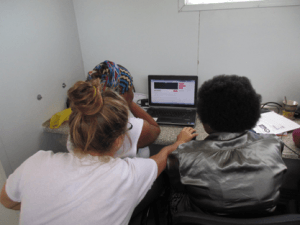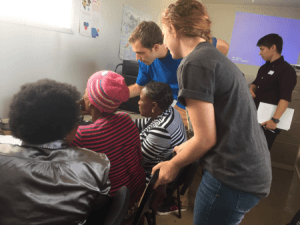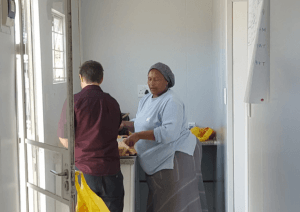The Teachers Take a Leap (October 30, 2015)
Backstory
Up until now, we had been working with the core group of women in preparation for them to help facilitate the learning of the larger group. Our core group of women had been practicing with computers for almost a week, and were excited to use what they had learned to teach their friends in the larger group. The core group had become much more comfortable operating a computer, and they were familiar with the basics of Facebook and Google, could operate computers relatively comfortably, and knew the main topics we wanted to cover in this initial large group session.
Cast of Characters
Pilot Trainees: This group consists of 6 members of Sizakuyenza’s Women’s Network, they come from a wide variety of backgrounds and all have their own reasons for wanting to learn computer skills. They had a variety of previous experiences with computers and other technology, but they were all excited to learn more and practice their skills. More can be read about each of the individual women by following the links below.
Our co-researchers outside the shipping container in which the trainings occurred
Setting
For the large group session, we moved outside of Sizakuyenza’s main offices and into a shipping container that has been converted into an office and serves as the base of operations for the Inyanda Youth Network. This provided us with more space at the cost of connection to Sizakuyenza’s WiFi, so we came prepared with a wireless hotspot that provided Internet connection from cell signal. The day started with a brief training session with the whole group, where everyone watched some essential computer skills be explained and performed on a projector at one end of the container. We then broke into smaller groups, which consisted of two women and one member of the WPI team, with Sbu floating between all of the groups to help with interpretation. The long and thin nature of the container allowed all of the groups to set up in front of a computer in a line along the wall. The scene below is split into 4 sections, with each member of the WPI team detailing their unique experience in their group.
Planning Questions
We had a lot of questions going into Friday, most of which were speculative.
- Was the core group ready to teach technology to the six additional women?
- How well did the larger group understand English?
- Were we as prepared to engage the larger group as we though we were?
- Did the larger groups’ enthusiasm mirror that of the core group?
Scene
Brendan
Brendan working with Nonkanyiso and Bukiwe
For the most part, I was working with two ladies who were not members of the core group, due to the hectic formation of these small groups. It was soon clear that the barrier between English and Xhosa would pose difficulty grasping the abstract concepts that computer skills rely so much on. This communication gap posed a significant problem. The seating arrangement seemed organic, with women who were good friends likely to sit next to each other when they first came in, and naturally worked amongst themselves when a computer was placed in front of them.
When I first sat down with the two ladies to help them with some starting computer skills, like moving the mouse around and clicking on things, they seemed to understand what I was telling them and would replicate what I was doing with an expected amount of difficulty. However, they seemed to understand and I figured that they had likely never used computers and may not be too talkative with someone new (though they did chat amongst themselves a decent amount in Xhosa). At some point there seemed to be a communication breakdown, and the only way to communicate with them was to point at something and say “click here”, which is not at all the method of teaching our team was hoping for. It was at this point that I moved away from being able to physically demonstrate what I wanted to teach the ladies and realized that they were not shy, they just did not understand what I was saying. They too realized that they could not understand and called for Sbu to help out, which brightened my spirits, because it showed that they really did want to learn.
Naturally, Sbu turned out to be a huge help and could determine what they were having difficulty with. As it happens, I was wrong in thinking that they were all set with moving the mouse and clicking. Specifically, one women was struggling with figuring out where the mouse pointer would go when they moved the actual mouse on the table. This is something that I had not anticipated at all and proves that some things that I take for granted to be simple concepts can be really difficult to grasp when learning computers for the first time. Sbu was interrupted by a phone call shortly after making a plate into a makeshift mouse pad with up, down, left and right labeled on an axis. Sbu’s departure reminded me that he was not a replacement for one of the core group of women and could not be expected to sit down and one-on-one teach the ladies.
Despite Sbu’s departure, his plate axis was successful and the two women were moving the mouse around with relative ease, and this time I was sure that they were ready to move on. I knew that to move on I would need someone who spoke Xhosa and English to help out with this and I asked Dube to leave her group for a moment to help out since her group seemed to be in a good place. Dube came over and was able to help out for a short time before we broke for lunch. I would definitely say that my experience with the two ladies was quite an exercise in patience, and I will not lie by saying I was not frustrated, but I am glad this happened early on as it allows us as a group to address the issue and hopefully avoid a similar situation moving forward.
Marguerite
Marguerite assisting Thembisa and Sylvia
After breaking off into pairs, I began working with Sylvia and Thembisa. Like the day before, Sylvia seemed to be unsure of her skills; she knows what she is doing, but is usually a little hesitant, so unlike some of the other pairs I sat behind these women the entire time. Because of my location, I could sit back and watch or intervene when it seemed appropriate. The other woman I was working with admitted she had never touched a computer before, but has seen her daughter use one proficiently. It was amazing how quickly she picked up on the things Sylvia was showing her. Part of this might have been due to the fact that she is younger than Sylvia and most of the other group members. I’m not sure of her exact age, but she is likely in her 30s or so. Because of how quickly the woman Sylvia was teaching learned, they were able to get a lot done in two short hours.
They had started off practicing getting on the Internet, getting to Google, searching a topic, looking at that topic for a few minutes, and then exiting out to start all over again. The topics they chose seemed odd, consisting of work, cars, and drugs. Although they seemed random, it was very interesting to see what they were looking for out of some of these searches. When they looked up ‘cars’ they explained it was because they hoped to eventually learn how to drive one. They really discovered the depth of the information available on the Internet when they looked and read new articles discussing “self-driving cars.” By the time they had googled drugs they really had a handle for what they were doing, so I sat back to see where they were going with this search. They ended up on a website reading profiles of people who overcame their addictions. I wondered if this would be one of the first searches for a white South African? A black American? A white American? The idea of searching drugs very well could be a result of the atmosphere in their community.
Once they had exhausted their interest in Google searching for the day, Sylvia practiced logging on to Facebook and showing the other woman how to search for friends. They spent the remainder of the training trying to find their friends, most of whom did not end up having Facebook profiles. However, she was able to find some of her nieces and nephews. They had more success when looking up younger people. Among their generation, a Facebook network still needs to be built, but there is no reason they cannot be the ones starting the movement in their community once they spread the skills they are learning.
Jenn
Jenn helping Brendan communicate difficult concepts
I worked with Thandi and one of the new women, Lulama. Because of Thandi’s hesitance to speak up and ask questions earlier in the week, I was worried about how she would be able lead someone else in learning about new technology. However, she took great initiative in showing Lulama how to use the mouse and the keyboard. She only occasionally needed help, and so I only interjected when she asked questions and tried to give her as much independence as possible. Thandi seemed much more excited about learning today than she did any day so far, and seemed to really enjoy showing off the skills she gained during the week.
Thandi struggled in teaching more when it came to the Internet and Google searching. I had to do a lot more hands-on teaching here, but I still tried to let her teach on her own as much as possible and get practice figuring things out on her own. Sbu was able to step in and help her with scrolling on the Internet, which was something that she struggled with a lot before. It was a relief to see her understanding something I had previously had trouble explaining to her, and I was thankful that Sbu was able to find a way to communicate the ideas I was struggling to explain.
About halfway through the training, Thandi left to make lunch for the group, so I stepped in to help teach Lulama. Since most people were on Facebook at the time, Sbu asked if I would help her set up an account, which required setting up an email first. She didn’t speak as much English as Thandi, and I got the sense that she wasn’t understanding everything I said while explaining the signup process. Despite this, she understood enough to provide the information needed to make the account. She seemed to start to lose interest as I explained a little about how email works, so I quickly asked if she wanted to move to making a Facebook account. She said she wasn’t interested in that, which made me realize I had made a mistake in assuming that she wanted to do what the rest of the group was doing. I asked her what she wanted to do instead, which she replied to by asking what she needed to do. It was difficult for me to communicate the idea that she could do whatever she wanted. I wanted to keep the question open so that she would not feel pressured into doing whatever I suggested first, but without being exposed to computers more, she could not be expected to know what was available to her. I eventually suggested a typing practice that some of the women were doing, which she seemed most enthusiastic about. She seemed to enjoy this activity, and learned very quickly with typing. It was encouraging to see this, and it made me hope that this would allow her to be enthusiastic coming back the next week even though we spent a lot of time working on things she wasn’t very interested in.
Emily
Emily and Thandi preparing group lunch
Once we broke into small groups I had a very different view of the functionality of our first big group session from most of my counterparts. Unlike Marguerite, Brendan, and Jenn, I didn’t have a designated group of women to work with because my group would have been with Dube, who seemed to be very comfortable teaching. Due to this, I was able to float from group to group more easily and see how everything was progressing. It was interesting to note the places where certain co-researchers excelled and places where others struggled. This was entirely due to the gaps in our previous days of teaching, however, the solutions these women came up with were truly creative.
When there were problems in the smaller groups I was able to float in and help only enough to come to a solution for the situation. The difficulties seen in the different groups were an interesting reflection of where our focus with the small group was lacking. I was able to take notes on what we need to make sure to hit on in the core group as well as different teaching methods that worked well for the co-researchers imparting information to the larger group. The most effective transmission of information seemed to be a method where the co-researcher did an action and then the new person repeated the same action. As the teaching progressed, it was clear to see that there was a significant stratification between those who had used a computer before and those who had not.
As it neared lunchtime, I headed over to give Vuyiswa a hand making sandwiches for the group. After a while Thandi took over, and she and I worked to make a sandwich assembly line. It was a nice to be able to work with Thandi, one of the quieter co-researchers. She was very intentional in her movements; every flick of her wrist had a purpose, every shuffle an end goal. We talked only to communicate what needed to be done and how to complete the task at hand. While we worked, her demeanour softened and she began to joke with me about the illogical set up of some programs. It was nice to see this side of her and it was a bridge I was happy to build
Reflection and Learning
As a whole, our experiences gave us valuable insight into both effective teaching methods and the amazing value of our co-researchers. The amount of computer knowledge that the women in the larger group came in with was much more diverse than in the smaller group, and it changed the way in which the teaching process could be conducted to an extreme not seen in the smaller, co-researcher group. We saw how important hands-on learning was when teaching computers for the first time, as well as the significance of translation when building foundational knowledge. The women who were not afraid to explore and experiment on the computer got through a lot more things on the first day, and so it will be important for us to encourage this spirit moving forward. While it is incredibly intimidating to be put in front of a computer for the first time, in order for us to help them learn we have to keep showing them that there is no reason to be intimidated by computers and help them to keep trying. In terms of the core group of women, seeing how happy they were helping other women will hopefully keep them motivated to learn more things as they move forward.
These experiences showed that some tangible changes needed to be made in the way that we conduct our sessions. Now that we know who we can communicate with the best and who is most intuitive with computers, we can pair the women off more easily. This will hopefully benefit both the women and us, as they will learn more and we will be able to work with each group of women in similar and, hopefully, stress-free way.
It was also seen in the whole group that sometimes there was a disconnect between what the whole group is doing and what the individual women wanted. Our team will need to develop a way to address this in the future so that the women will see the best possible results of this training. We will need to get to know all of these women more, because all of them have different interests, histories, and types of access to technology, which will drive the different things they want to learn. Talking to them about the trainings will also be important to get their feedback so that they feel more comfortable and be more motivated to learn on their own. It was amazing to see the women show a lot of interest in what we were doing and grow in the process.







